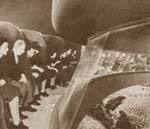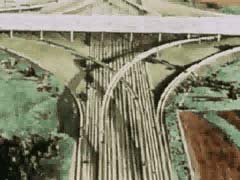 |
|
futurama, autogeddon |
|
Imagining the Superhighway from Bel Geddes to Ballard |
|
four: the highways of tomorrow
[13] The underbelly of this bright look into the future is, to our eyes and ears, quite obvious. Megan Shaw and Rick Prelinger, in discussing the narratives of manifest destiny so freely used in the imagination of future highways, note that borrowing from a pre-twentieth-century paradigm for an understanding of the uniquely twentieth-century road-building technology that freeways represent has left us open to the dissonances that arise from the conflict between the lived experience of freeways in the late twentieth century and the remembered experience of free horizons that we were drawing on when we built them (19). The triumphant presentation of "an American city replanned around the highly developed modern traffic system" ("To New Horizons") carries rather more scary connotations to a people who have endured fifty years of the gutting of the inner city to make way for arterial bypasses, as well as the noise and air pollution that came with them. Urban renewal, though, seemed to the people of the post-depression a welcome relief; David Gelertner reports that "[T]he depression made the utopian future an urgent and compelling belief" (51). Social welfare being virtually nonexistent in the United States (as it continues to be, by the standards of many countries), the onus was on urban planners and engineers such as Le Corbusier and Robert Moses to find ways to create more pleasant urban environments. Unfortunately, urban planners responded by sweeping the social problem under the carpet, with the approbation of the middle-class public. One of the scariest parts of the narration of the film enacts this version of social Darwinism with the following statement: On all express city thoroughfares, the rights of way have been so routed as to displace outmoded business section and undesirable slum areas whenever possible. Man continually strives to replace the old with the new. The power of the highway to enact social renewal is thus symbolic of a more insidious possibility: the engineering of the world of tomorrow by urban planners. Bel Geddes' dream of Futurama is haunted by the dark ghost of social engineering. |
| 1 |
| 2 |
| 3 |
| 4 << |
| 5 |
| 6 |
| 7 |
| 8 |
| 9 |
| 10 |
| credits |
| rhizomes |
 [12]
The second part of the film documents closely Bel Geddes' diorama,
sweeping over the scale models and coming in for close-ups as the narrator
continues to speak. Chief among these scenes are the "highways of tomorrow"
with their lovingly detailed tiny cars (bulbous, streamlined and brightly
colored, unlike the bland black cars in the parking lots outside the fair!).
The magnificent overpasses and sweeping curves ("highway engineering at
its most spectacular") both act as a monument to the conquering of space
and stand in for more general scientific and social change: "This 1960
drama of transportation progress is but a symbol of future progress in
every activity, made possible by constant striving toward new and better
horizons." The final cuts, featuring animations of highways and the streamlined
abstract curves so prevalent in graphic design of the time, suggest a
continued movement forward into the future, motivated by the metaphor
of the highway.
[12]
The second part of the film documents closely Bel Geddes' diorama,
sweeping over the scale models and coming in for close-ups as the narrator
continues to speak. Chief among these scenes are the "highways of tomorrow"
with their lovingly detailed tiny cars (bulbous, streamlined and brightly
colored, unlike the bland black cars in the parking lots outside the fair!).
The magnificent overpasses and sweeping curves ("highway engineering at
its most spectacular") both act as a monument to the conquering of space
and stand in for more general scientific and social change: "This 1960
drama of transportation progress is but a symbol of future progress in
every activity, made possible by constant striving toward new and better
horizons." The final cuts, featuring animations of highways and the streamlined
abstract curves so prevalent in graphic design of the time, suggest a
continued movement forward into the future, motivated by the metaphor
of the highway.